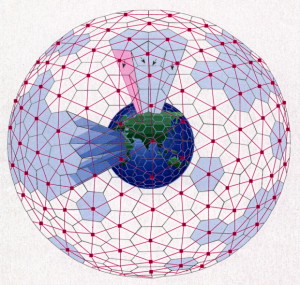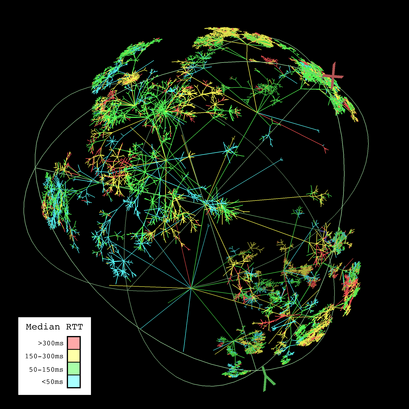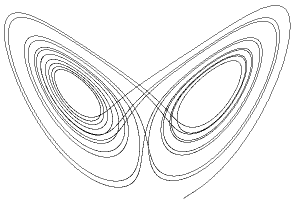The inner workings of the internet mind
Meteorologist Lewis Frye Richardson's 1922 paper on modeling the weather postulated a hyperball computer, with 64,000 nodes made up of computing human beings. His fascinating ideas are now encapsulated in the computer networks that do weather prediction. Idealized Hyperball network |
I got the word "Hypersphere" from a friend last week, savored it, and ultimately googled for the origin, finding a 2003 speech on immortality by Gordon Bell Prize winner Philip Emeagwali: Computing in the future will be distributed on computers interconnected in a hyperball network. The personal computers of the future will primarily be used to access more remote computers that are more powerful than any computer that exists today. As computing shifts from the computer to the Internet, the World Wide Web evolves into an intelligent superorganisms or "brain of brains," which I will call a superbrain. The superbrain has a hyperball interconnection pattern with billions of nodes. Each node is powered by both a human- and computer-brain. |
|
After reading his speech I kept thinking not about connectivity, but about conversation, about chemistry, about memes like "Political climate" and "blogosphere". I thought about how different transmission speeds were between an idealized hyperball or NUMA computer, a network, and people... The word "web", as in "world wide web", started to bother me. I sat back in my chair, closed my eyes, and tried to visualize what the web really looked like. While the idea of a "web" is hopelessly two dimensional, and a hyperball more appropo', reality remains more complex. "A brain of brains" wasn't quite it, either. An organism of organisms... An organism of thinking organisms... hmm... A thinking organism of thinking organisms... | |
 | Then I discovered the wonderful work being done by the CyberGeography project. This graph represents physical topography of a real network, but it also resembles the virtual topography of the blogosphere. Champion bloggers like Lessig and Searls have influence and connections much like the pattern on the lower right, with a cluster of connections closely intersecting, while the hat pattern in the center is like that of someone using conventional broadcast media.
I like that data flow in this representation appears spherical. (it isn't actually, it's hyperbolic, but I digress) The speed of light around the half the circumference of the earth is as fast as communication is going to get. |
 | Light can get halfway around the globe in .067 of a second. In this graph it takes me .33 of a second for me to ping china.
Not bad factoring in the innumerable routers, cables, firewalls, and modems between here and there! Where it once took months for a small packet of information to be brought around the world by sailing ship Everyone on the internet can reach everyone else in seconds. Meatspace has no meaning. We've already lifted free of the physical and entered the virtual. Each mind on the internet is already in something more complex than a hypersphere, already potentially connected to n minds, where n = the number of users on the net. But we don't have telepathy, what we have is approximations for it (text, pictures, moving pictures, voice) that we've encapsulated in technology that can transmit at nearly lightspeed. We're actually connected in something more like a fractal pattern. People in israel, australia, and china can get to any article within seconds of posting it, but they don't. Why? While we strive towards communication at the speed of thought, we're still incapable of receiving more than one conversation at a time. |
- Metcalfe's law: The usefulness, or utility, of a network equals the square of the number of users.
 Lorenz Bloggers act as strange attractors | While apparently chaotic, webbed conversation is self-organising. It has many of the features demonstrated by simpler systems like Daisyworld and Life, except that people and computers are part of the program. Google relies on people organising the web as much as people rely on google to organise the web. A computer cluster and a people cluster operate in symbiosis. Right around now, this author started thinking of the web, not as a web, but of an organism of organisms. It's a dynamic, living thing. The spread of thought waves is like weather. Each piece of text on the internet is the flapping of a butterfly's wings.
When thinking about people try to remember what you aren't measuring. We've only managed to encapsulate thought as text so far. All the products of the other senses remain out of reach. Unencapsulated. For all the audio data that's on the internet, there's no search engine that scans an mp3 for what it actually says. There's nothing that can capture the esthetic of a sculpture, the taste of love, or the smell of jasmine - if these are the things you are searching for on the internet, you need to experience them for yourself. |
People have tried to visualize how people interact in artificial environments like LambdaMOO:
 | If you define metcalfe's law's "usefulness" as the ability to communicate, clearly, two of the purest forms of telepathy are mathematics and programming, but even then, if you don't know the language, you aren't going to communicate. Clear writing in english is no help when speaking to a non-english speaker, either. Movies, especially silent movies, bridge the gap between cultures, but even the best translated talkies can leave foreign audiences puzzled at shortcuts in the visual grammar.
The only people interacting in the game to the left are people that can type, enjoy text-based virtual reality, and were logged in over the sampling period. A very small segment of humanity. Each is the center of their own story, their own n-wide hypersphere of history, connections and communication, and only within this virtual world do some of the points of their personalities intersect. The most popular networked games today consist of very basic survival strategies - find/kill the stranger being predominant - and have little to do with communication and thought itself. What role would games like these play in a "brain of brains?". Very little. But in an organism of organisms, they make a lot of sense. Survival of an organism makes sense. |
Since we don't yet have a jack in our heads for telepathy, what substitutes? Conversation.
I like to think of that initial conversation as an extension of talking to oneself, where thought = talking to oneself. First you engage in personal reflection, then you look for a reflection from someone else. It's rare that you submit that first thought to someone you don't like. Sometimes you get good feedback, and the conversation extends. Depending on the strength of the thought/meme/blog you revise it, and send it out into the ether to be devoured by your eager listeners/readers.
 a thought's influence over time | Pre-blog/pre-google there it would sit, unlistened to, unread. Oh, if you posted to usenet news, you might get a group of people that were already interested in what you said, but just to the web? Nothing. If you were a newspaper columnist you had readers in syndication, but outside that? Nothing. It's a bigger world than that now.
In it, everyone's talking, and few are listening. When a conversation takes place (people comment on other sites) the amplitude of a thought wave rises above the background noise. |
Strange attractors (champion bloggers) redirect and reflect and amplify the thought. Ultimately a search engine listens in, and the conversation is stored in global long term memory. Sometimes a thought gets amplified so loud that it makes a jump from the internet to conventional media - I've been really struck lately, by how often the economist picks up on a web trend two-three weeks after it passes by in conversation.
Visualize yourself as a cluster of competing thought-waves, as lightweight and as transparent as an atom, amid other clusters of competing thoughtwaves... a one of 6 billion passing in space and time within the hyperball surrounding the earth... think about the parts of you you've pushed into cyberspace, and how much you depend on the part of others. Think of how your ideas would have spread in the days of the Conestoga wagon, or in the days of city to city phone service.
When worlds collide
A bassist in SF may play a jazz gig one day and classical the next - the various spheres co-exist in the same space (music), but rarely intersect. What a chess player does in New York has no noticible effect on the bass player in San Francisco, so long as they are playing simultaneously.
But it would be really difficult to play chess in New York if you could hear the bass player in San Francisco - and every musician in-between the cities, which is where attenuation comes in. Thankfully, sound attenuates in air. Text attenuates in the web.
Now - as soon as their efforts are transferred into a transmission medium (the musician gets on radio, the chess player in the paper) they *can* affect one another... but no matter the medium, over these distances, it's directional. The receiver has to tune in.
Books, magazines, newspapers, radio, television, the web, email, blogs, and instant messaging all are partial encapsulations of telepathy - ideas in flight - and if you wonder why is it that it's so hard to change the world? The connections between our minds demonstrates hysteresis.
I'm going off to hang with a couple other strange attractors at LinuxWorld, and see if I can get this thought reflected, refracted, or amplified. I'm trying to describe how the web - an organism of thinking organisms - thinks. While I've tried to demonstrate today that the speed of thought around our shared globe is plenty fast, it ain't nothing compared to the speed of reflection around a shared beer.
mike





